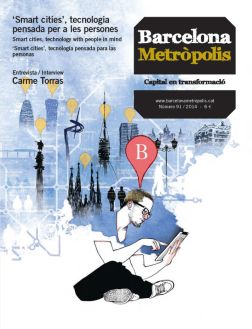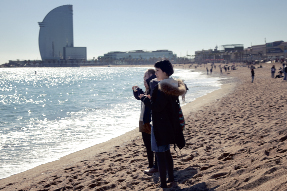Venice is a cosmopolitan city with a notable aesthetic aspect to it. Barcelona is a sunny, Mediterranean city which has transformed itself in a very short time through urban development. Hence the Italians’ unanimously enthusiastic reaction whenever they hear the city’s name: “Bellissima!”

© Camilla de Maffei
The DHUB building, at Plaça de Les Glòries.
All Italians are deeply envious of Barcelona’s dynamism and the urban redevelopment that has taken place under the democratic city councils.
Many years ago, when I was living in the USA, I was once asked the inevitable “where are you from?” When I replied “from Barcelona”, the girl stared at me and then asked, with a notable look of surprise: “So what are you doing here?” That must have been in 1998. I was in Wellesley, a town outside Boston, not the worst city in the country, just a provincial, snobbish one. The question epitomises the surprise felt by anyone unable to understand how I could have lived so far away from the marvellous, prodigious, exciting, attractive city of their dreams. A few years previously – before 1992 – the girl would have asked me if I was Mexican.
As you well know, there was a basic transformation in the perception of Barcelona abroad before and after its Olympics Games and subsequent transformation into an international tourist destination. The images of the trampoline jumps, showing the city in the background, for all the haze, the spectacular images of athletes in action, provided the best publicity for many years. And the image remains, despite the notoriety the city has earned itself in the tourist rankings as the world capital of pickpockets, though the authorities seem none too concerned about that.
Back in 1992, the number of television programmes, books, special magazine issues (on food, on tapas [sic]) did a lot to attract interest in a city off the radar of international travellers until then. It was neither the first nor the last time that I was asked that question. Woody Allen’s infomercial or publicity documentary added further reasons for the city’s attraction and promoted the mirage of exoticism for foreigners keen to visit Barcelona. The growing interest turned into courses on Barcelona and modernity, taught by myself and many colleagues, invariably arousing great interest in people, promoting slightly more cultivated tourists and raising the number of enrolled students, which is of the utmost concern to departmental deans and directors in the North American university system, governed as it is by the relentless laws of supply and demand.
The situation before 1992 is well known. It was a grey city that tourists spending a few days in Lloret or Salou tried to avoid. The best image I ever saw of that time – I know I didn’t dream it – was in a short film shown at the Publi or the Alexis, cinemas that screened “Arthouse” films then. It must have been in 1971. The film was by Els Joglars, an ironic take on the activities tourists could do in Barcelona at the time. I remember two things from it: a deep-sea diver emerging from a sewer manhole on C/ Pelai and looking round, to the surprise of pedestrians, and a group of tourists having a picnic on Montcada Hill, next to the Asland factory. Absurd locations for such ordinary activities in other places. No one – apart from Carles Soldevila, the creator of an original guide in 1929, L’art d’ensenyar Barcelona [The Art of Showing Barcelona] – could have suspected what would happen here twenty years later.
Now I’ve swapped music. Less jazz and more Vivaldi and gondolier songs. Everyone in Italy admires Barcelona and knows it is the favourite city for thousands of Italians (50,000?) who have taken refuge there, to escape from Berlusconi and the mafiosi politics corrupting the Right and the Left in the sub-alpine country. Barcelona’s Italian residents even have their own, very active, association, Altraitalia (www.altraitaliabcn.org/ca), with its own spirited slogan: “They can cut down all the flowers but they can’t prevent spring”. Many are fighting against Italy’s moral, social and political decline. Devastated, they see how their host country’s TV stations, public and private alike, increasingly resemble the tele-trash that is typical of Italian TV stations. These are owned by the corrupt and indicted tycoon, while the public ones imitate their model to survive in a cut-throat market, in search of the tyrannical “screen share”. The list of my Venetian friends with one or more children who have emigrated to Barcelona is impressive.
The Italians discovered Spain in 1982, through the emotive images of President Pertini hugging the king of Spain every time Italy scored a goal at the World Cup. According to the stereotype, Italians and Spaniards/Catalans are very similar. Nothing could be further from the truth. We could say they are good Valencian cousins. But from distant families. I can only understand the Piemontese (pure Languedoc) and Venetian dialects, which happen to preserve, by a series of happy coincidences, many words and similar sounds. Venetian-Italians have a few images of Barcelona that merely reflect the Spanish cliché or stereotype: they love our food (“khamón” pata negra); many are keen tifosi of Barça, besides their own Italian team, and the young dream about or remember the nights of the Barcelona movida (no point trying to explain the meaning). Those who fancy themselves as connoisseurs pronounce the “c” in the city’s name like a long “s”.
Venice and Barcelona resemble one another in many ways, but they are quite different too. Venice is a cosmopolitan city with a notably aesthetic dimension and awareness to it. Its film festival, the Biennale, regularly puts it at the centre of the international world of culture. Barcelona is a sunny, Mediterranean city that has transformed itself over a short space of time through urban development. Hence the Italians’ unanimously enthusiastic reaction whenever they hear the city’s name: “Bellissima!” We often forget that Venice’s latitude makes it a northern city with a cold, rainy and misty climate.
Two things unite them: opera and tourism. Both the Fenice (1996) and the Liceu (1994) opera houses were destroyed by fire under circumstances that have never been fully explained. Lovers of both cities fall into groups of sophisticated people, true devotees of the bel canto, of high opera culture, with powerful “Friends of the Liceu/Fenice” associations. During the high season the tourist invasion takes over both cities. Barcelona comes off better as it has more space and, so long as you keep away from the centre, the Raval and the Barri Gòtic, you hardly notice the massive presence of foreigners. Over there, like here, the top luxury shops have been employing Russian-speaking staff to attend to visitors from the Russian Federation for years. Venice has only 57,000 inhabitants but the average number of tourist overnight stays is 65,000 a night. A city with more visitors than residents. A few urban-planning sociologist friends regard them technically as city residents in law, who should be paying taxes like everyone else.
Venice receives over 23 million visitors every year. The reaction against tourists is much fiercer than it is in Barcelona, as its residents are only too aware of what is at stake: the frailty of an extremely delicate urban fabric. Narrow little streets and discourteous tourists do not make for an easy coexistence. And what about sovereignty? Do people talk about it? They do. But it’s clear they don’t really understand it in Venice. Because, to the Venetian mind, talk of sovereignty is very similar to the arguments of the Northern League, a disgraceful xenophobic group. I am often called on to explain the basic differences between the two demands.
I ask an artist friend from Alto Adige (Southern Tirol), who shuttles between Venice and New York, what she thinks of Barcelona. She replies bluntly: “Decidedly post-modern. Design, design and design. So it’s not contemporary.” But all Italians are deeply envious of Barcelona’s dynamism and the urban redevelopment that has taken place under the democratic city councils. Another friend who worked for Venice’s municipal International Water City Centre association, now closed because of cuts, tells me that the Arsenale’s possibilities are immense and would make Barcelona’s Moll de la Fusta and beaches pale in comparison. The Lido beach is sensational. But she bemoans the fact that, because Italians lack the tradition of a strong state, they are incapable of working as a team or “di squadra”, as she puts it. Compared to Italy’s overly complex bureaucratic system, our system seems positively Swedish.
As we get older, we fall more and more under the spell of the Ptolomy Syndrome and we like to believe we are the centre of the universe. We hardly move. After years of sailing round the world, on transoceanic pendolarismi (voyages), Barcelona is much closer now. I feel it is like a neighbourhood in this impossible Europe we dream of building. Low-cost (and less comfortable) flights take me there and give me the sensation that everything is closer. Maybe we should call it the Mediterranean. A North American friend once said to me, after seeing a CAT sticker with the European flag on my car: “I like utopias.”




